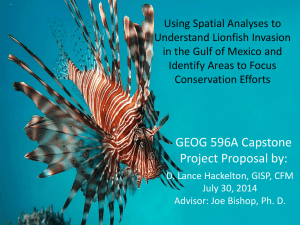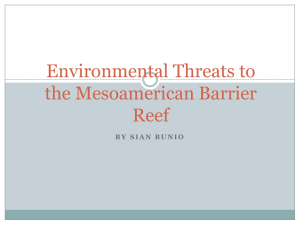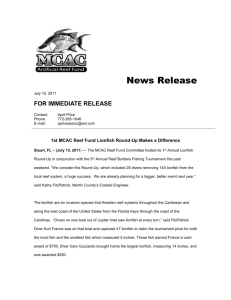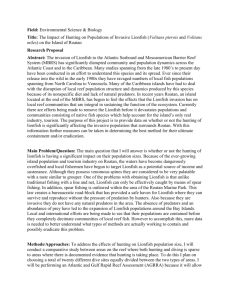Document 11671500
advertisement
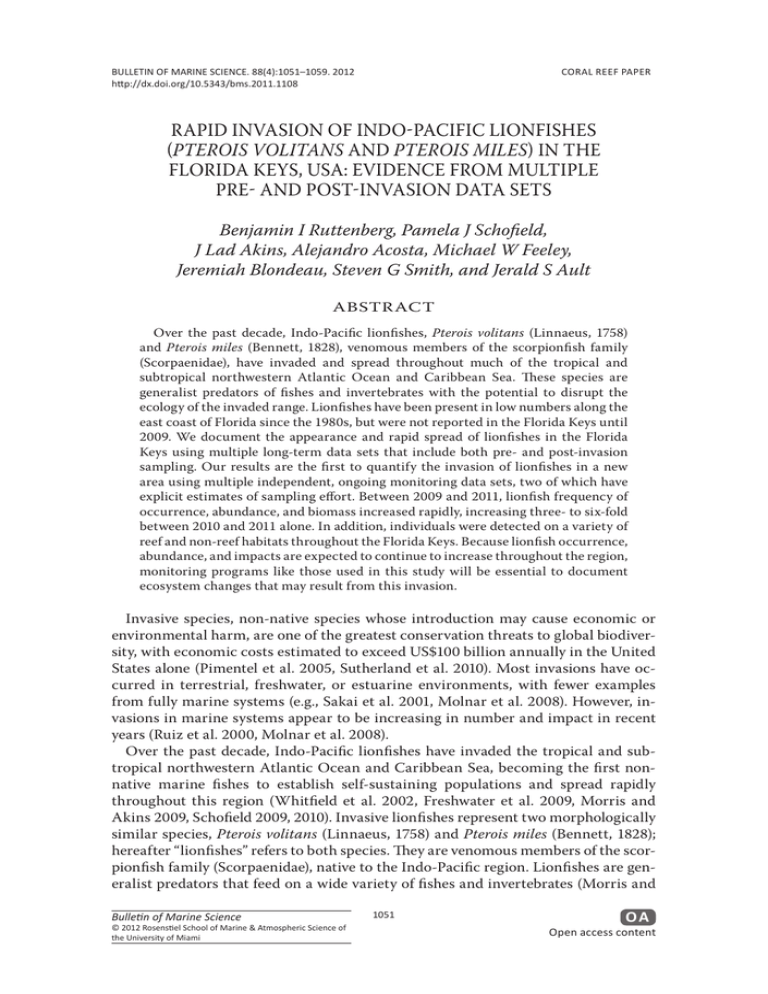
BULLETIN OF MARINE SCIENCE. 88(4):1051–1059. 2012 http://dx.doi.org/10.5343/bms.2011.1108 CORAL REEF PAPER RAPID INVASION OF INDO-PACIFIC LIONFISHES (PTEROIS VOLITANS AND PTEROIS MILES) IN THE FLORIDA KEYS, USA: EVIDENCE FROM MULTIPLE PRE- AND POST-INVASION DATA SETS Benjamin I Ruttenberg, Pamela J Schofield, J Lad Akins, Alejandro Acosta, Michael W Feeley, Jeremiah Blondeau, Steven G Smith, and Jerald S Ault ABSTRACT Over the past decade, Indo-Pacific lionfishes, Pterois volitans (Linnaeus, 1758) and Pterois miles (Bennett, 1828), venomous members of the scorpionfish family (Scorpaenidae), have invaded and spread throughout much of the tropical and subtropical northwestern Atlantic Ocean and Caribbean Sea. These species are generalist predators of fishes and invertebrates with the potential to disrupt the ecology of the invaded range. Lionfishes have been present in low numbers along the east coast of Florida since the 1980s, but were not reported in the Florida Keys until 2009. We document the appearance and rapid spread of lionfishes in the Florida Keys using multiple long-term data sets that include both pre- and post-invasion sampling. Our results are the first to quantify the invasion of lionfishes in a new area using multiple independent, ongoing monitoring data sets, two of which have explicit estimates of sampling effort. Between 2009 and 2011, lionfish frequency of occurrence, abundance, and biomass increased rapidly, increasing three- to six-fold between 2010 and 2011 alone. In addition, individuals were detected on a variety of reef and non-reef habitats throughout the Florida Keys. Because lionfish occurrence, abundance, and impacts are expected to continue to increase throughout the region, monitoring programs like those used in this study will be essential to document ecosystem changes that may result from this invasion. Invasive species, non-native species whose introduction may cause economic or environmental harm, are one of the greatest conservation threats to global biodiversity, with economic costs estimated to exceed US$100 billion annually in the United States alone (Pimentel et al. 2005, Sutherland et al. 2010). Most invasions have occurred in terrestrial, freshwater, or estuarine environments, with fewer examples from fully marine systems (e.g., Sakai et al. 2001, Molnar et al. 2008). However, invasions in marine systems appear to be increasing in number and impact in recent years (Ruiz et al. 2000, Molnar et al. 2008). Over the past decade, Indo-Pacific lionfishes have invaded the tropical and subtropical northwestern Atlantic Ocean and Caribbean Sea, becoming the first nonnative marine fishes to establish self-sustaining populations and spread rapidly throughout this region (Whitfield et al. 2002, Freshwater et al. 2009, Morris and Akins 2009, Schofield 2009, 2010). Invasive lionfishes represent two morphologically similar species, Pterois volitans (Linnaeus, 1758) and Pterois miles (Bennett, 1828); hereafter “lionfishes” refers to both species. They are venomous members of the scorpionfish family (Scorpaenidae), native to the Indo-Pacific region. Lionfishes are generalist predators that feed on a wide variety of fishes and invertebrates (Morris and Bulletin of Marine Science © 2012 Rosenstiel School of Marine & Atmospheric Science of the University of Miami 1051 OA Open access content 1052 BULLETIN OF MARINE SCIENCE. VOL 88, NO 4. 2012 Akins 2009), and can dramatically reduce the densities of juvenile reef fishes (Albins and Hixon 2008). As a result, lionfishes may have significant impacts on reef communities as they expand their range and abundance in the invaded region (Morris and Whitfield 2009, Albins and Hixon 2011). Lionfishes were first reported in the Atlantic Ocean off of mainland Florida in 1985 (Whitfield et al. 2002, Morris and Akins 2009), but sightings in the southeastern USA remained extremely rare through the late 1990s. In the early 2000s, increasing numbers were reported on offshore reefs of North Carolina (Morris and Whitfield 2009, Schofield 2009). Lionfishes appeared in The Bahamas in 2004 and have increased markedly in density and occurrence (Green and Cote 2009, Albins and Hixon 2011). Since 2006, lionfishes have spread through the Caribbean Sea, tropical northwestern Atlantic, and Gulf of Mexico (Schofield 2009, 2010). Anecdotal reports suggest that frequency of occurrence and density have increased rapidly following initial colonization, and several studies have documented increases in North Carolina and parts of the Caribbean (Claydon et al. 2009, Morris and Whitfield 2009, Albins and Hixon 2011). Despite reports of lionfishes throughout much of the Caribbean, there were no confirmed reports in the Florida Keys through 2008, and few reports during 2009. Sightings increased greatly throughout the Florida Keys in 2010 and 2011. To quantitatively evaluate this trend, we used data from multiple pre- and postinvasion monitoring data sets to document the increase of lionfishes in a variety of habitats in the Florida Keys. Those data included a sophisticated federal and state agency-sponsored monitoring program and an extensive citizen-science monitoring program, both of which had been in place for at least 15 yrs prior to the lionfish invasion. In addition, we examined data from a federal agency database on lionfish sightings from numerous sources, including private citizens. Collectively, these data sets allowed us to establish the first pre-invasion baseline for the Florida Keys and track the progress of the invasion following initial colonization. Methods The Florida Keys reef tract is a complex barrier reef system that extends 250 km from Miami south and west to Key West and another approximately 125 km west to the Dry Tortugas. It contains a variety of habitats including: inshore, mid-channel, and offshore patch reefs (all found behind the reef crest with increasing distance from shore); spur and groove, reef slope, and patch reef habitats on the forereef; extensive mangrove and seagrass areas; and artificial reefs (Keller and Causey 2005). We used three different data sets to examine several measures of the rate of the lionfish invasion across a range of habitats within the main Florida Keys (i.e., Key Largo to Key West) between 2009 and 2011. First, we used data from the Reef Visual Census (RVC) monitoring program, a collaborative federal and state government-sponsored fishery-independent monitoring program in the Florida Keys ongoing since 1980. The RVC program uses highly trained scuba divers to record the size and abundance of all diurnally active reef fishes within a sample area in a 7.5 m radius circular plots (Bohnsack and Bannerot 1986, Smith et al. 2011a). Each year, sample locations are randomly selected using a habitat-stratified survey design at depths from approximately 3 to 30 m (see Brandt et al. 2009, Smith et al. 2011a for details of sampling methodology). Divers record the precise latitude and longitude of each sample. RVC sampling occurs annually during the summer months between May/June and August/September. Second, we examined data from the Reef Environmental Education Foundation (REEF) Volunteer Survey Project (see Pattengill-Semmens and Semmens 2003 for more information about this program). The REEF program uses data recorded by volunteer diver, RUTTENBERG ET AL.: LIONFISH INVASION IN THE FLORIDA KEYS 1053 citizen-scientists during recreational dives at a wide variety of sites. Divers use the “Roving Diver Technique” in which divers swim freely throughout a dive site and record the presence and categorical abundance [single (1), few (2–10), many (11–100), and abundant (>100)] of every observed fish species that can be positively identified. Each dive is treated as a sample. Sites are identified by name and latitude and longitude. REEF assigns each diver to a skill category (“Novice” or “Expert”) based on their experience, tested knowledge of local species, and number of samples conducted. We restricted our analysis of this data set to sites in the Florida Keys and to data collected by “Expert” divers only. Finally, we included information on sightings of lionfishes in the Florida Keys from the US Geological Survey (USGS) Nonindigenous Aquatic Species (NAS) database (Schofield et al. 2011). The USGS-NAS database is the national repository for georeferenced sightings of nonnative aquatic species. USGS does not employ a monitoring program itself; instead it collects and collates reports from other government agencies (federal, state, municipal), academia, non-governmental organizations, and the public. Each report was reviewed and vetted by USGS data managers to ensure validity and accuracy before being entered into the database. To standardize observations among data sources, we assigned a shelf position and habitat class to each RVC and REEF sample location using a benthic habitat map of the Florida Keys (see Brandt et al. 2009, Smith et al. 2011a for details). Inshore areas (all areas landward of the forereef reef crest) contained only patch reef habitats; forereef areas included high-relief spur and groove reef, low-relief reef at shallow (<6 m), mid-depth (6–18 m), and deep (18–35 m) depths, and artificial reefs. We calculated frequency of occurrence of lionfish in each habitat class and shelf position from the RVC and REEF data sets, and an overall frequency of occurrence in the Florida Keys based on both data sets for 2009, 2010, and 2011. We define frequency of occurrence as the proportion of samples with lionfish present. The three data sets provided different metrics that allowed us to evaluate the timing and rate of the lionfish invasion in the Florida Keys. The RVC data set included size and abundance data as well as a defined area for each sample, allowing us to extract measures of lionfish density and frequency of occurrence. Multiple samples taken at each site allowed us to calculate estimates of variance for both density and frequency of occurrence following procedures for a two-stage stratified random design (Cochran 1977) using binomial estimates of variance for proportions for frequency of occurrence. Within-habitat estimates of mean density and frequency of occurrence, as well as their corresponding estimates of variance, were weighted by the proportion of area of each habitat in the Keys to generate Keys-wide estimates (see Brandt et al. 2009, Smith et al. 2011a,b for more details on sampling design and all computations). Response measures from the RVC data set were available for 2010 and 2011 (no lionfish were recorded in the RVC data set in 2009), and were calculated on an annual basis. The REEF data set included only a qualitative measure of abundance and a rough measure of effort (number of dives), from which we calculated frequency of occurrence and binomial estimates of variance. The USGS data set only provided the number of lionfish reports (with no explicit measure of effort). Because both REEF dives and USGS reports occurred throughout the year, we compiled those data for three time periods in each year for higher temporal resolution (spring: January–April; summer: May–August; fall: September–December); the bulk of diving surveys for REEF and RVC occur during the summer months, and diving activities are greatly reduced during the winter months in Florida. To provide an overview of the lionfish invasion, we examined each of the metrics described above at the habitat/location level for the RVC and REEF data, as well at the regional level (Florida Keys) for all three data sets. Results All three data sources showed similar trends in lionfish sightings in the Florida Keys (Table 1, Fig. 1). Prior to 2009, there were no reports of lionfishes in the Florida Keys by any source. In 2009, lionfishes were still uncommon; the RVC data set had 1054 BULLETIN OF MARINE SCIENCE. VOL 88, NO 4. 2012 Table 1. Percent occurrence (with sample size in parentheses) for RVC and REEF data sets in select habitats in the Florida Keys during 2009–2011. Habitats with low/no sampling effort and no lionfish sightings are not included, and habitats are non-overlapping. Inshore zone extends from the shoreline to the inside of the reef crest/forereef zone. NA = unsampled. Zone Inshore Forereef Forereef Habitat Patch reef Artificial reef/ habitat High relief spur and groove reef Forereef Low relief shallow reef (0–6 m) Forereef Low relief mid-depth reef (6–18 m) Forereef Low relief deep reef (18–30 m) RVC 2009 2010 2011 0% (148) 4.4% (97) 9.4% (96) NA NA NA 0% (196) 2.2% (153) 7.8% (210) REEF 2009 2010 2011 0.0% (3) 0.0% (6) 0.0% (3) 1.5% (66) 13.0% (46) 12.8% (47) 0.8% (132) 7.1% (70) 19.0% (79) 0% (93) 0.0% (74) 0.8% (55) 0.0% (3) 0% (46) 2.5% (34) 9.6% (14) 0.0% (62) 14.5% (55) 0% (46) 8.3% (34) 26.3% (14) 0.0% (3) NA 28.8 (66) 0.0% (35) 28.6% (14) 48.0% (25) no sightings of lionfishes at 491 sites, the REEF data set had two lionfish sightings in 303 samples (0.7% occurrence), and the USGS data set had 54 records of lionfish sightings, with half of these reported in the final four months of the year. In 2010 and 2011, lionfish sightings increased markedly. In the RVC data set, lionfish frequency of occurrence was 3.4% in 2010 and 10.7% in 2011 (403 and 410 samples, respectively). However, the deep forereef had the highest frequency of occurrence, with 8.3% in 2010 and 26.3% in 2011 (Table 1). The REEF data documented 23 sightings in 198 samples in 2010 (12% occurrence) and 52 sightings in 230 samples in 2011 (22.6%). Around 20% of REEF samples were conducted on artificial habitats (usually shipwrecks). Occurrence of lionfishes at these sites was 13.0% in 2010 and 12.8% in 2011, the only habitat category that showed no change in frequency of occurrence between 2010 and 2011. The USGS database had 54 lionfish sightings in 2009, 561 in 2010, and 534 in 2011. Lionfish sizes in the RVC data set ranged from 3 to 22 cm TL (mean 14.1 cm) in 2010 and 6 to 34 cm TL (mean 18.1 cm) in 2011; we used size data to calculate biomass following Barbour et al. (2011). Estimates of overall numerical density (1 SE) in increased from 1.6 (0.4) individuals (ind) ha−1 in 2010 to 6.0 (0.9) ind ha−1 in 2011, with the greatest densities in deep forereef habitats [5.1 (2.3) ind ha−1 in 2010 and 16.8 (4.7) ind ha−1 in 2011). Estimates of biomass density showed similar increases between 2010 and 2011 [overall: 0.11 (0.038) to 0.64 (0.13) kg ha−1; deep forereef: 0.34 (0.19) to 2.15 (0.78) kg ha−1). Between 2010 and 2011, the RVC data set showed a threefold increase in frequency of occurrence, a four-fold increase in mean density, and a six-fold increase in biomass. Differences were statistically significant for frequency of occurrence, density, and biomass at the 0.05 level (based on non-overlapping 95% CI) in the Florida Keys overall. Discussion We documented the rapid invasion of lionfishes in the Florida Keys using three monitoring data sets, all of which were ongoing for many years prior to initial lionfish sightings. Each of these data sets revealed a rapid increase in lionfish frequency of occurrence from 2009 to 2010 and 2010 to 2011. This increase from one year to RUTTENBERG ET AL.: LIONFISH INVASION IN THE FLORIDA KEYS 1055 Figure 1. Frequency of occurrence (FO) and number of sightings of lionfishes in the Florida Keys from 2009 to 2011. REEF and RVC data are shown as frequency of occurrence [left axis (SE)], and USGS are number of reported lionfish sightings (reports, right axis). REEF and USGS data are show for three periods per year (spring: January–April; summer: May–August; fall: September–December). REEF sample sizes by time period are: 28, 226, 49 (2009); 31, 139, 29 (2010); 27, 159, 34 (2011). RVC data include estimates of frequency of occurrence for the entire Florida Keys (open circles), as well as the deep forereef (dark triangles), the habitat with the highest occurrence. RVC sampling occurs only during summer as indicated. the next is similar to the pattern of invasion recorded in some other areas (Claydon et al. 2009, Morris and Whitfield 2009, Albins and Hixon 2011), but it is still unclear why lionfish abundance or frequency of occurrence increased quickly between years. It is possible that founder propagules colonizing an area remain undetected and are able to grow, mature, and reproduce quickly; data suggest that lionfish may reach reproductive maturity within a year of settlement (J Morris, unpubl data). High spawning frequency, as well as the unusual buoyant egg masses that lionfish produce, may facilitate synchronous recruitment in an area (Morris et al. 2011), particularly in the Florida Keys, where Florida Current eddy formation can influence recruitment patterns (e.g., D’Alessandro et al. 2007). However, the specific mechanisms leading to rapid population increases remain unknown. Although we quantified the sudden appearance of lionfishes in the Florida Keys, our data likely provide the minimum estimate of the abundance of these invasive predators. The RVC survey method uses a stationary point count, designed to detect conspicuous, diurnally active reef fishes (Bohnsack and Bannerot 1986). While divers swim around the sample area to collect habitat data after completing the fish count, lionfishes sometimes remain under overhangs or other structures where they may still evade detection. REEF divers swim actively through an area, attempting to identify every fish they see, but it is still possible that divers miss some individuals. It is likely that lionfishes were not detected in some of the samples in both programs because of their sometimes cryptic behavior, particularly during younger life stages and in higher relief, spur-and-groove forereef habitats (Kulbicki et al. 2012). In addition, because the REEF program uses opportunistic sampling from recreational divers, samples are non-random and there is a possibility that more popular dive sites 1056 BULLETIN OF MARINE SCIENCE. VOL 88, NO 4. 2012 may be sampled multiple times in a reporting period, leading to potential pseudoreplication. Therefore, we cannot extrapolate the patterns we observe in the REEF data set to the entire system. However, the trends in frequency of occurrence in the REEF and RVC data correspond well in both time and space. The USGS database relies on public reporting of lionfishes, as well as reports from governmental and non-governmental agency staff. As lionfishes invade a new area, reports increase quickly as the public becomes aware of the issue through the media and outreach efforts. As divers and fishers become acclimatized to the presence of lionfishes, reporting rates may slow. This may account for the decrease in lionfish reports in 2011, but we are unable to estimate this effect. In addition, recreational diving intensity varies seasonally in the Florida Keys (e.g., higher during the opening of lobster season in July and August, lower in the colder winter months). Lionfish sightings likely track overall diving activity, making it difficult to detect actual month-to-month changes in abundance using USGS-NAS data. However, the fact that reporting to USGS decreased in 2011 while frequency of occurrence increased in the RVC and REEF data sets suggests the public has become acclimatized to seeing lionfish. Public reporting may be most useful to track the initial colonization of new areas rather than increases in established populations (Schofield 2009, 2010). However, directed agency-run monitoring programs may be better tools for tracking population dynamics following initial establishment. This is the first instance in which multiple data sets with explicit estimates of sampling effort have documented the rapid increase of lionfishes in a newly invaded range. Frequency of occurrence in the RVC data set was consistently lower than in the REEF data set, but frequency of occurrence generally increased two- to three-fold in each data set in each habitat, and in the Florida Keys in general between 2010 and 2011. Artificial reef in the REEF data set was the only habitat category that did not change between 2010 and 2011 (13.0% and 12.8%, respectively). While they comprise an extremely small fraction of reef area in the Florida Keys (<<0.001%), artificial reefs are heavily used by divers. Many recreational divers have begun carrying lionfish-removal devices such as small spears, which may partly account for the lack of increase in frequency of occurrence between 2010 and 2011 in this habitat. Overall, these results suggest that data from citizen-science monitoring programs accurately detect the timing of changes (e.g., appearance) and trends reported in agency monitoring programs, and may also augment less frequent monitoring from agency monitoring programs (e.g., REEF sampling occurs year-round while RVC sampling occurs only in summer). Although volunteer, citizen-science programs have some pitfalls (e.g., non-random sampling, potential pseudoreplication), they are particularly valuable in places where professional, long-term monitoring programs do not exist, such as in much of the developing world where the majority of coral reefs are found. Citizen-science programs have the potential to detect early stages of other invasions and potential long-term effects of invasions on the entire community over spatial and temporal scales that more sophisticated agency monitoring programs often cannot cover. Based on patterns seen in other areas, we anticipate that lionfishes will continue to increase in occurrence and abundance in the Florida Keys (Claydon et al. 2009, Green and Cote 2009, Morris and Whitfield 2009, Albins and Hixon 2011); our data show an increase in frequency of occurrence, mean density, and biomass of lionfish of three- to six-fold between 2010 and 2011 alone. Such rapid increases in abundance RUTTENBERG ET AL.: LIONFISH INVASION IN THE FLORIDA KEYS 1057 may strongly influence local reef fish communities (Albins and Hixon 2008, Morris and Akins 2009, Cote and Maljkovic 2010, Green et al. 2012). Existing monitoring programs, such as those used in the present study, will provide some information about the scope of these impacts in the Keys, but additional information on the status of juvenile and cryptic reef fish communities is urgently needed since those communities are likely to be heavily impacted by lionfishes (Albins and Hixon 2008, Green et al. 2011). In addition, lionfishes appear to use multiple non-reef habitats (Barbour et al. 2010, Jud et al. 2011), many of which are key nursery areas for economically and ecologically important reef fishes. Supplementary monitoring efforts will be needed to document the prevalence and spread of these invasive predators in such habitats. Finally, long-term data collection efforts like these will be essential to documenting the spread and impacts of lionfishes throughout the invaded range. Acknowledgments We thank the dozens of divers and hundreds of people who conducted RVC and REEF surveys and sent lionfish reports to the USGS database. This research would have been impossible without their efforts. We are especially grateful to P Barbera, B Binder, M Dancy, A Estep, A Davis, D Gothan, J Javech, A Johnson, L Jones, D McClellan, D Morley, L Richter, J Simonds, W Sympson, M Tellier, and R Waara for the many hours spent monitoring reef fish communities in the field, to A Benson, D Gregoire, A Johnson, C Pattengill-Semmens, S Smith, B Witcher, and N Zurcher for database management, and to J Bohnsack, J Serafy, and many of the above-mentioned people for helpful guidance and discussions. This work was supported in part by the Florida Fish and Wildlife Conservation Commission, the National Park Service, the NOAA Southeast Fishery Science Center, the NOAA Coral Reef Conservation Program, the Reef Environmental and Educational Foundation (REEF), US Fish and Wildlife Service (Region 4) and the US Geological Survey’s Invasive Species Program. Literature Cited Albins MA, Hixon MA. 2008. Invasive Indo-Pacific lionfish Pterois volitans reduce recruitment of Atlantic coral-reef fishes. Mar Ecol Prog Ser. 367:233–238. http://dx.doi.org/10.3354/ meps07620 Albins MA, Hixon MA. 2011. Worst case scenario: potential long-term effects of invasive predatory lionfish (Pterois volitans) on Atlantic and Caribbean coral-reef communities. Environ Biol Fish. http://dx.doi.org/10.1007/s10641-011-9795-1 Barbour AB, Allen MS, Frazer TK, Sherman KD. 2011. Evaluating the potential efficacy of invasive lionfish (Pterois volitans) removals. PLoS One. 6(5):e19666. PMid:21572951. PMCid:3091870. http://dx.doi.org/10.1371/journal.pone.0019666 Barbour AB, Montgomery ML, Adamson AA, Diaz-Ferguson E, Silliman BR. 2010. Mangrove use by the invasive lionfish Pterois volitans. Mar Ecol Prog Ser. 401:291–294. http://dx.doi. org/10.3354/meps08373 Bohnsack JA, Bannerot SP. 1986. A stationary visual census technique for quantitatively assessing community structure of coral reef fishes. NOAA Technical Report NMFS 41. Brandt ME, Zurcher N, Acosta A, Ault JS, Bohnsack JA, Feeley MW, Harper DE, Hunt JH, Kellison GT, McClellan DB, et al. 2009. A cooperative multi-agency reef fish monitoring protocol for the Florida Keys coral reef ecosystem. Natural Resource Report NPS/SFCN/ NRR—2009/150. National Park Service, Fort Collins, Colorado. Claydon JAB, Calosso MC, Jacob SE. 2009. The red lionfish invasion of South Caicos, Turks & Caicos Islands. Proceedings of the 61st Gulf and Caribbean Fisheries Institute. 61:400–402. Cochran WG. 1977. Sampling Techniques, 3rd Edition. New York: John Wiley and Sons. 1058 BULLETIN OF MARINE SCIENCE. VOL 88, NO 4. 2012 Cote IM, Maljkovic A. 2010. Predation rates of Indo-Pacific lionfish on Bahamian coral reefs. Mar Ecol Prog Ser. 404:219–225. http://dx.doi.org/10.3354/meps08458 D’Alessandro E, Sponaugle S, Lee T. 2007. Patterns and processes of larval fish supply to the coral reefs of the upper Florida Keys. Mar Ecol Prog Ser. 331:85–100. http://dx.doi. org/10.3354/meps331085 Freshwater DW, Hines A, Parham S, Wilbur A, Sabaoun M, Woodhead J, Akins L, Purdy B, Whitfield PE, Paris CB. 2009. Mitochondrial control region sequence analyses indicate dispersal from the US East Coast as the source of the invasive Indo-Pacific lionfish Pterois volitans in The Bahamas. Mar Biol. 156:1213–1221. http://dx.doi.org/10.1007/ s00227-009-1163-8 Green S, Akins J, Cote I. 2011. Foraging behaviour and prey consumption in the Indo-Pacific lionfish on Bahamian coral reefs. Mar Ecol Prog Ser. 433:159–167. Green SJ, Akins JL, Maljkovic A, Cote IM. 2012. Invasive lionfish drive Atlantic coral reef fish declines. PLoS One. 7(3):e32596. PMid:22412895. PMCid:3296711. http://dx.doi. org/10.1371/journal.pone.0032596 Green SJ, Cote IM. 2009. Record densities of Indo-Pacific lionfish on Bahamian coral reefs. Coral Reefs 28:107–107. http://dx.doi.org/10.1007/s00338-008-0446-8 Jud ZR, Layman CR, Lee JA, Arrington A. 2011. Recent invasion of a Florida (USA) estuarine system by lionfish, Pterois volitans / P. miles. Aquat Biol. 13:21–26. http://dx.doi. org/10.3354/ab00351 Keller BD, Causey BD. 2005. Linkages between the Florida Keys National Marine Sanctuary and the South Florida Ecosystem Restoration Initiative. Ocean Coast Manage. 48(11– 12):869–900. http://dx.doi.org/10.1016/j.ocecoaman.2005.03.008 Kulbicki M, Beets J, Chabanet P, Cure K, Darling E, Floeter SR, Galzin R, Green A, HarmelinVivien M, Hixon M, et al. 2012. Distributions of Indo-Pacific lionfishes Pterois spp. in their native ranges: implications for the Atlantic invasion. Mar Ecol Prog Ser. 446:189–205. http://dx.doi.org/10.3354/meps09442 Molnar JL, Gamboa RL, Revenga C, Spalding MD. 2008. Assessing the global threat of invasive species to marine biodiversity. Front Ecol Environ. 6:485–492. http://dx.doi. org/10.1890/070064 Morris JA, Akins JL. 2009. Feeding ecology of invasive lionfish (Pterois volitans) in the Bahamian archipelago. Environ Biol Fish. 86:389–398. http://dx.doi.org/10.1007/s10641-009-9538-8 Morris JA, Sullivan CV, Govoni JJ. 2011. Oogenesis and spawn formation in the invasive lionfish, Pterois miles and Pterois volitans. Sci Mar. 75:147–154. http://dx.doi.org/10.3989/ scimar.2011.75n1147 Morris JA, Whitfield PE. 2009. Biology, ecology, control and management of the invasive IndoPacific lionfish: an updated integrated assessment. NOAA Technical Memorandum NOS NCCOS 99. Pattengill-Semmens CV, Semmens BX. 2003. Conservation and management applications of the reef volunteer fish monitoring program. Environ Monit Assess. 81(1–3):43–50. PMid:12620003. http://dx.doi.org/10.1023/A:1021300302208 Pimentel D, Zuniga R, Morrison D. 2005. Update on the environmental and economic costs associated with alien-invasive species in the United States. Ecol Econ. 52(3):273–288. http:// dx.doi.org/10.1016/j.ecolecon.2004.10.002 Ruiz GM, Fofonoff PW, Carlton JT, Wonham MJ, Hines AH. 2000. Invasion of coastal marine communities in North America: apparent patterns, processes, and biases. Annu Rev Ecol Syst. 31:481–531. http://dx.doi.org/10.1146/annurev.ecolsys.31.1.481 Sakai AK, Allendorf FW, Holt JS, Lodge DM, Molofsky J, With KA, Baughman S, Cabin RJ, Cohen JE, Ellstrand NC, et al. 2001. The population biology of invasive species. Annu Rev Ecol Syst. 32:305–332. http://dx.doi.org/10.1146/annurev.ecolsys.32.081501.114037 Schofield PJ. 2009. Geographic extent and chronology of the invasion of non-native lionfish (Pterois volitans [Linnaeus 1758] and P. miles [Bennett 1828]) in the western North Atlantic and Caribbean Sea. Aquat Invasions. 4:473–479. http://dx.doi.org/10.3391/ai.2009.4.3.5 RUTTENBERG ET AL.: LIONFISH INVASION IN THE FLORIDA KEYS 1059 Schofield PJ. 2010. Update on geographic spread of invasive lionfishes (Pterois volitans [Linnaeus, 1758] and P. miles [Bennett, 1828]) in the western North Atlantic Ocean, Caribbean Sea and Gulf of Mexico. Aquat Invasions. 5:S117–S122. http://dx.doi.org/10.3391/ai.2010.5.S1.024 Schofield PJ, Morris JA, Langston JN, Fuller PL. 2011. Pterois volitans/miles. USGS Nonindigenous Aquatic Species Database, Gainesville, FL. Available from: http://nas. er.usgs.gov/queries/factsheet.aspx?speciesid=963. Revision date: 9/16/2011. Smith SG, Ault JS, Bohnsack JA, Harper DE, Luo J, McClellan DB. 2011a. Multispecies survey design for assessing reef-fish stocks, spatially explicit management performance, and ecosystem condition. Fish Res. 109:25–41. http://dx.doi.org/10.1016/j.fishres.2011.01.012 Smith SG, Swanson DW, Chiappone M, Miller SL, Ault JS. 2011b. Probability sampling of stony coral populations in the Florida Keys. Environ Monit Assess. 183(1–4):121–138. PMid:21547375. http://dx.doi.org/10.1007/s10661-011-1912-2 Sutherland WJ, Clout M, Cote IM, Daszak P, Depledge MH, Fellman L, Fleishman E, Garthwaite R, Gibbons DW, De Lurio J, et al. 2010. A horizon scan of global conservation issues for 2010. Trends Ecol Evol. 25:1–7. http://dx.doi.org/10.1016/j.tree.2009.10.003 Whitfield PE, Gardner T, Vives SP, Gilligan MR, Courtenay WR, Ray GC, Hare JA. 2002. Biological invasion of the Indo-Pacific lionfish Pterois volitans along the Atlantic coast of North America. Mar Ecol Prog Ser. 235:289–297. http://dx.doi.org/10.3354/meps235289 Date Submitted: 11 October, 2011. Date Accepted: 14 August, 2012. Available Online: 13 September, 2012. Addresses: (BIR, JB) National Marine Fisheries Service, Southeast Fisheries Science Center, 75 Virginia Beach Dr, Miami, Florida 33149. (PJS) US Geological Survey, 7920 NW 71st St, Gainesville, Florida 32653. (JLA) Reef Environmental Education Foundation (REEF) P.O. Box 246, Key Largo, Florida 33037. (AA) Florida Fish and Wildlife Conservation Commission, Fish Wildlife Research Institute, 2796 Overseas Hwy, Suite 119, Marathon, Florida 33050. (MWF) National Park Service, South Florida and Caribbean Network, 18001 Old Cutler Rd, Suite 419, Palmetto Bay, Florida 33157. (SGS, JSA) University of Miami, Rosenstiel School of Marine and Atmospheric Science, 4600 Rickenbacker Causeway, Miami, Florida 3314. Corresponding Author: (BIR) Email <benjamin.ruttenberg@noaa.gov>.
